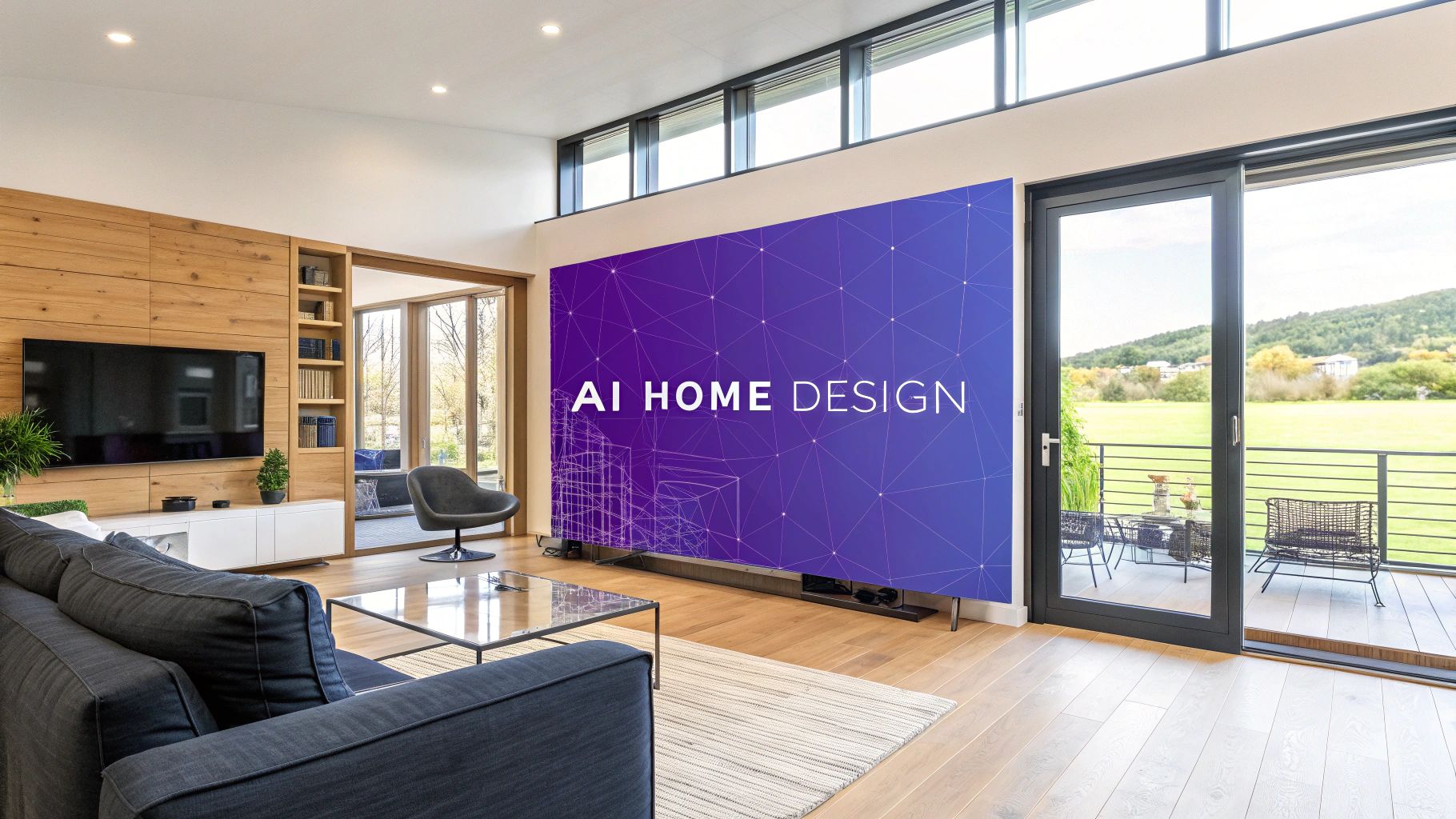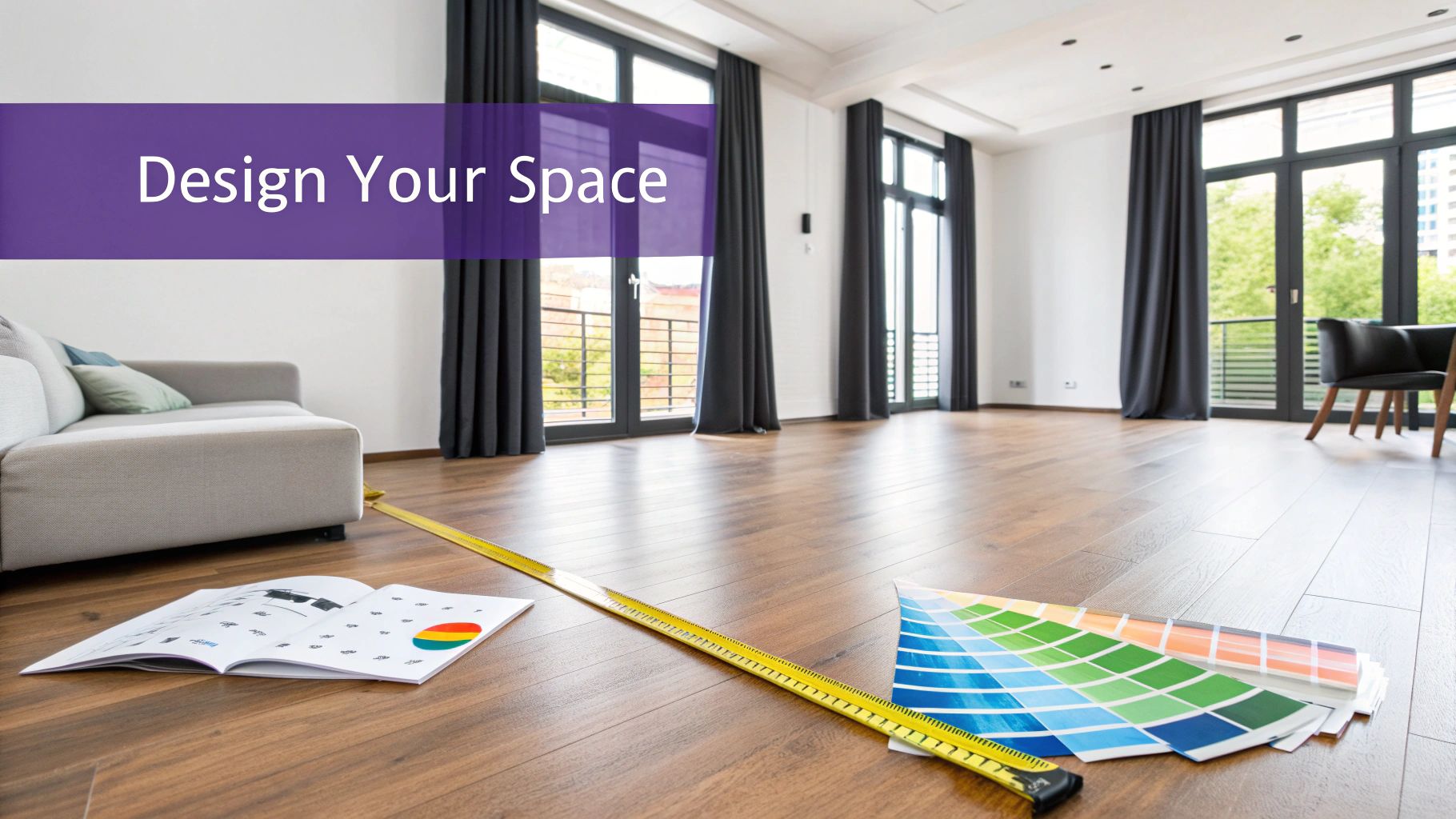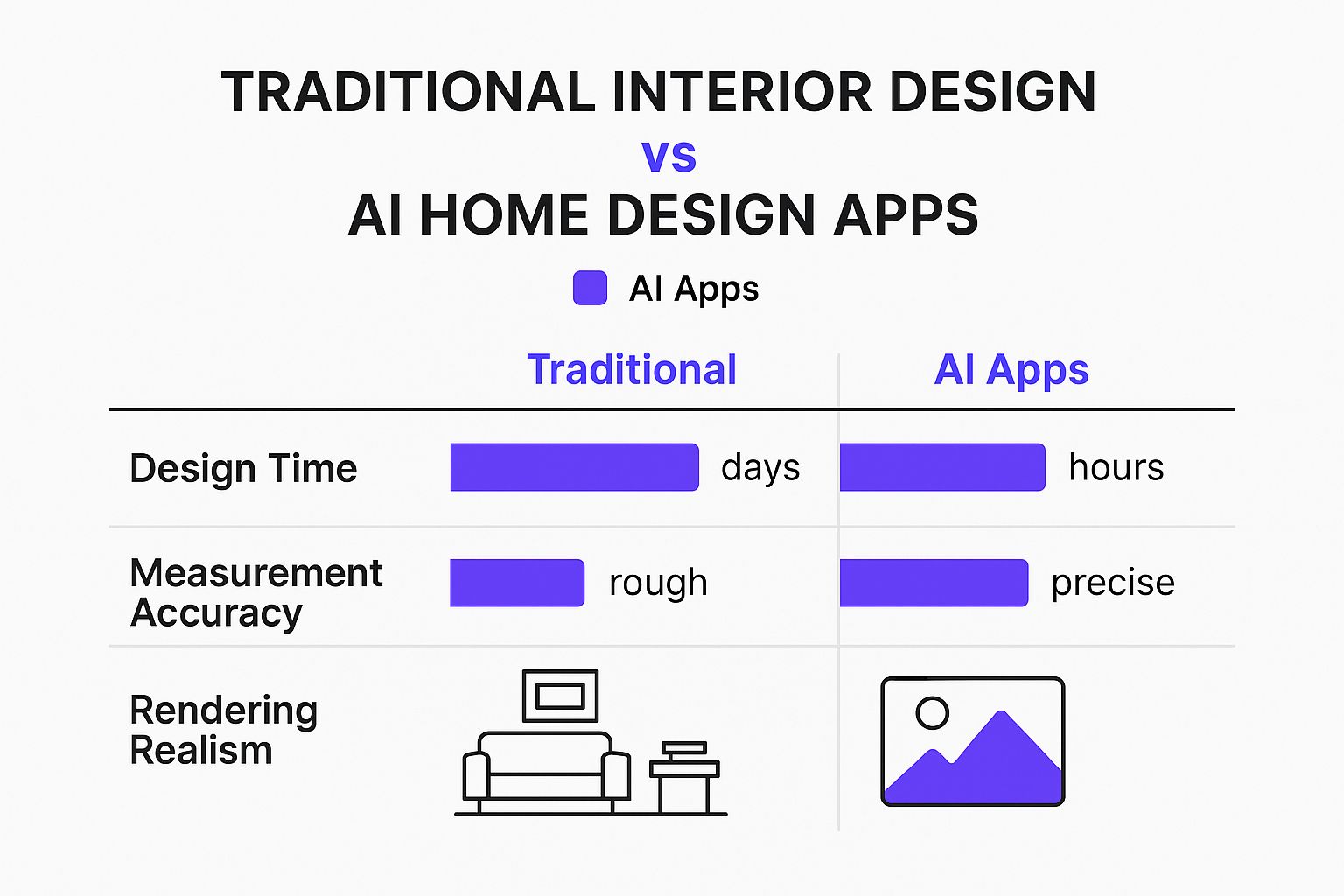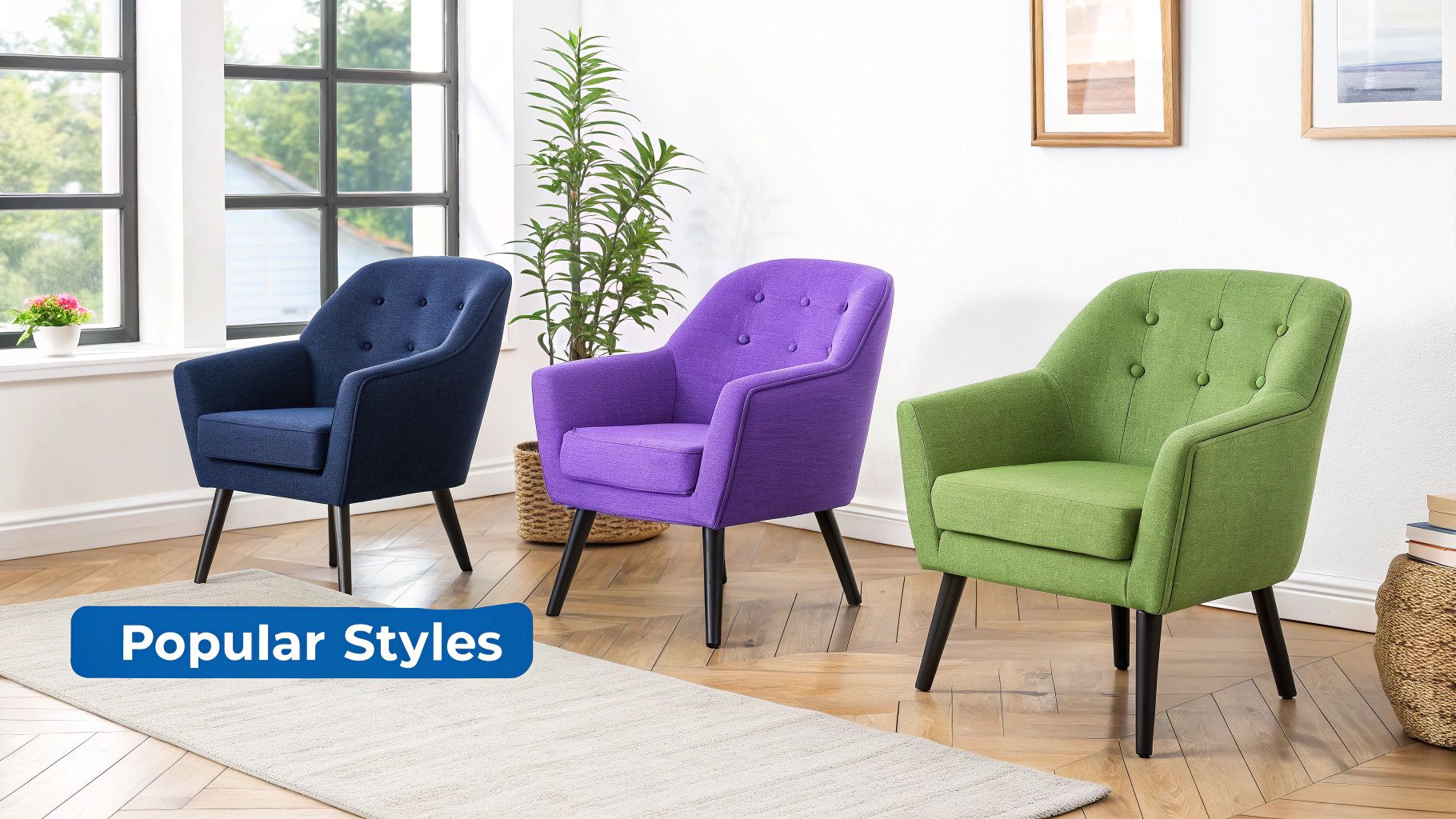Top AI Home Design Apps to Visualize Your Space
Discover the best AI home design apps to transform your home. Learn how to visualize furniture, test styles, and create your dream interior with ease.

Ever stared at an empty room, completely stumped? Or maybe you've got a space that just feels… wrong. We’ve all been there, armed with a handful of paint swatches and a measuring tape, just hoping for the best. That whole process is a recipe for anxiety and expensive mistakes. This is where AI home design apps come in, acting like a personal interior designer right on your phone or computer.
Welcome to the Future of Interior Design

This guide is all about showing you a smarter way to design your home. We're moving past the guesswork and into a world where you can feel confident in every choice you make. We’ll break down how this technology lets you see exactly what your room will look like, helping you build a home that's a perfect reflection of you.
Visualize Before You Buy
The biggest promise of AI home design apps is incredibly simple: no more buyer's remorse. Let's say you're going for a sophisticated California Cool aesthetic. You find a stunning linen slipcovered sofa from a brand like Maiden Home, but you're nervous about how its relaxed silhouette and specific fabric will actually look with your other furniture.
The old way meant ordering fabric samples, measuring your space ten times, and trying to piece it all together in your head. It was a lot of work and a lot of wishful thinking. Now, things are so much easier.
The real magic of these new AI tools is how they close the gap between browsing online and seeing the result in your home. They give you a realistic preview that lets you trust your decisions.
Hyper-Realism and True Dimensions
Not all design apps are the same. A lot of them give you a basic, cartoonish mockup, but aiStager is the only solution that generates hyper-realistic photos using true dimension rooms and furniture objects. This is huge. It means what you see on your screen is a genuinely accurate preview of how that piece will fit and feel in your actual space.
This level of detail is a total game-changer, especially when you're stuck between a few different options. You can instantly test-drive furniture without leaving your couch.
- Test different brands: Wondering how a sofa from West Elm stacks up against a similar one from Crate & Barrel? See them both in your living room in seconds.
- Compare colors and finishes: Instantly swap that leather chair for a performance fabric version, or see if a light oak coffee table works better than dark walnut.
- Check proportions: Make sure that giant sectional you love won't completely swallow your room, or confirm the new side table is the right height.
With a tool like aiStager, the process is incredibly straightforward. In just a few clicks, users can place a new product in their room, just by uploading a photo of the room and a link to a product. It takes all the uncertainty out of the equation, so you can focus on creating a space you’ll absolutely love.
How AI Home Design Apps Actually Work
So, what’s really going on inside these design apps? It’s not magic, but it’s pretty close. Think of it less like a cold piece of software and more like a creative partner—one that just happens to understand space, light, and style in a deeply technical way. It takes a simple photo of your room and turns it into a digital sandbox, a place where you can experiment freely without moving a single piece of heavy furniture.
The whole process kicks off with a technology called computer vision. When you upload a picture, the AI scans it much like an experienced designer would, quickly sizing up the room's key features. It identifies walls, windows, doorways, and even the furniture you already have. This first step is what turns your flat photo into a dynamic canvas, ready for a makeover.
Next, machine learning algorithms step in. These have been trained on millions of interior design images, so they’ve learned what makes different styles tick, from Mid-Century Modern to the Organic Modern look popular in many US homes. This is how they can suggest layouts, color palettes, and furniture pairings that actually make sense for your space and the style you're going for.
From Pixels to a Plan
The main goal is to transform your photo into an environment you can actually work with. This is where different AI home design apps start to show their true colors. Some will give you a basic 2D floor plan or a simple 3D model, which are fine for rough brainstorming. The real game-changer, however, are the tools that aim for something far more convincing.
The most advanced apps don’t just create a sketch; they build a virtual replica of your room. This allows you to visualize changes with a level of realism that was previously only available to professional design studios.
This leap in technology is what makes these tools so incredibly useful. Instead of just guessing if a new sofa will fit, you can see its exact proportions in your living room. The industry's rapid growth reflects just how much people want these smarter design solutions. The AI interior design market, currently valued at around USD 1.47 billion, is expected to jump to nearly USD 6.96 billion by 2032, all thanks to these powerful new capabilities. You can see more details on this market expansion over at GlobeNewswire.
Photorealism and Dimensional Accuracy
This brings us to two crucial ideas that separate the good apps from the truly great ones: photorealism and dimensional accuracy.
Photorealism is all about the AI's ability to create an image that looks like a real photograph. It has to get the lighting, shadows, and textures just right to create a believable scene. If you want to dive deeper into this, check out our guide on interior design rendering.
But dimensional accuracy is arguably even more important. This is what guarantees that both your room and the virtual furniture you place in it are true to scale. This is where a platform like aiStager really shines, as it’s the only solution that generates hyper-realistic photos with true dimension rooms and furniture objects.
Let’s say you’re torn between two sofas for your family room—the sleek, low-profile Andes Sectional from West Elm or a deeper, plusher model from Crate & Barrel. With aiStager, this isn't a guessing game. You upload a photo of your room, provide a link to each sofa, and in a few clicks, the app generates a photorealistic image showing exactly how each option would look in your home, down to the correct size, color, and finish. This ability to test-drive real products from any brand is what finally takes the anxiety out of making those big-ticket purchases.
Core Features That Redefine Room Planning
Modern AI home design apps have come a long way from the clunky floor planners of the past. Today’s tools are loaded with smart features that totally change how you tackle a room makeover, turning what used to be a headache into a fun, creative journey. They bring professional-grade visualization right to your fingertips.
At their heart, these apps are masters of Virtual Staging. If you’re staring at an empty room, this feature can instantly fill it with furniture based on a style you like, whether it's rustic Modern Farmhouse or clean Scandinavian. It’s a fantastic way to see a room's potential without trying to guess what fits where.
Then there’s Style Generation. You can upload a photo you love from Pinterest or choose from a built-in style library, and the AI will whip up a complete mood board. It suggests furniture, paint colors, and decor that all work together, acting like your personal design assistant to ensure everything looks cohesive.
Test Real Products in Your Actual Room
The real game-changer, though, is seeing actual products from real stores in your own space before you spend a dime. This is where the anxiety of online shopping meets the reality of your home, and it’s a feature where platforms like aiStager truly shine.
Let’s say you’re eyeing that beautiful Sven Charme Tan leather sofa from Article. You love how it looks online, but you’re worried it might overpower your living room or clash with your rug.
With aiStager, that uncertainty is gone. It’s the only tool that creates hyper-realistic photos with true dimension rooms and furniture objects. You just upload a picture of your room and drop in the link to the sofa. In moments, you get back a photorealistic image showing exactly how it will look and fit.
This isn’t just a cool gimmick; it fundamentally changes the design process. You're no longer looking at rough mockups or cartoonish 3D models. You’re seeing a dimensionally accurate preview that helps prevent expensive mistakes and gives you the confidence to click "buy."
Comparing Options Instantly
This technology really proves its worth when you're stuck between a few choices. Maybe that Article sofa looks amazing, but you're also curious about a cozy fabric sectional from West Elm.
With just a few clicks, you can place the West Elm sectional in your room and compare it side-by-side with the leather one. You can even test different colors and fabrics. See how a light gray sectional looks versus a navy velvet one, all in your room’s unique lighting. This kind of A/B testing removes all the guesswork.
To get a sense of how different platforms package their features, you can explore Timbercloud's feature set for a real-world example of what these tools offer.
The table below breaks down just how different this new approach is from the old way of doing things.
Comparing Traditional Design vs AI-Powered Design
This table highlights the key differences in process, cost, and outcome between traditional interior design methods and using modern AI home design apps.
| Aspect | Traditional Method | AI Home Design App |
|---|---|---|
| Process | Involves manual measurements, physical samples, and hand-drawn or complex 3D sketches. | Upload a photo and use AI to automatically generate layouts, styles, and product visualizations. |
| Time | Can take days or weeks to create a single design concept. Revisions are slow and laborious. | Generates multiple high-quality design concepts and revisions in minutes or hours. |
| Cost | Often requires hiring a professional designer, which can be expensive. | Low-cost subscription models or free versions make professional-grade tools accessible to everyone. |
| Visualization | Relies on mood boards and sketches that can be hard to interpret. | Provides hyper-realistic, dimensionally accurate photos of how furniture will look in your actual room. |
| Flexibility | Experimenting with different layouts or furniture is time-consuming and costly. | Instantly swap out products, change colors, and test different layouts with a few clicks. |
It's clear that AI-powered tools not only speed things up but also deliver a far more realistic and reliable preview of the final result.

This visual drives the point home: AI tools shrink design timelines from days down to hours while producing results that are far more accurate and true-to-life than manual methods.
Optimizing Your Layout with Confidence
Beyond just placing furniture, advanced AI home design apps also help with Layout Optimization. After you’ve picked your main pieces, the AI can suggest the best arrangements for both function and style. It thinks about traffic flow, where to put the focal point, and basic design principles to help you create a room that not only looks great but is also easy to live in.
This is a huge help whether you’re trying to make a small apartment feel bigger or figure out the best way to arrange a large, open-concept space. This blend of realistic product visualization and smart layout advice empowers you to plan your room with an expert’s eye, making sure the final result is perfect.
Bringing Popular Design Styles to Life

One of the best things about AI home design apps is how they turn abstract ideas into something you can actually see. You’re no longer just saving pictures of rooms you like; you’re bringing that exact feel into your own space. This tech acts as a bridge between your vision and reality, letting you test-drive popular design aesthetics without moving a single piece of furniture.
This ability to experiment is a big deal. It’s why the global interior design software market, valued at USD 5.37 billion, is expected to jump to USD 9.66 billion by 2030. People want personalized homes, and these apps are making that dream more accessible than ever.
These tools are especially good at translating popular styles—like the ones you see all over US homes—into your specific room, ensuring the final look feels authentic to both the style and to you.
Creating a Modern Farmhouse Dining Room
Let's say you're dreaming of a Modern Farmhouse dining room. It’s a style that mixes rustic comfort with clean, contemporary lines, but getting that balance just right can be a real headache. A common sticking point is the dining table—how do you find one that feels substantial without being clunky?
With a tool like aiStager, the guesswork is gone. You just upload a photo of your dining room and provide a link to a product you’re considering, like a solid oak table from Restoration Hardware. The app will place it right in your room.
Not quite right? In a few clicks, you can swap it for a different model, maybe one with sleek black legs. You could even add some contrasting black Windsor chairs from Pottery Barn to see how the whole set works together. What you get back is a hyper-realistic photo showing you exactly how that furniture will look with your existing lighting and floors.
Experimenting with Organic Modern Textures
Maybe your taste is more Organic Modern, a style built on natural materials, neutral colors, and soft, curved shapes. Here, texture is everything. But it’s also one of the hardest things to gauge from an online product photo.
Imagine you want a cozy accent chair. You’ve found a beautiful Bouclé chair from Lulu and Georgia, but you also saw a similar one at CB2. Which texture and shade of white will actually work with your sofa and rug?
This is where aiStager shines. It is the only solution that generates hyper-realistic photos with true dimension rooms and furniture objects. You can upload a link to both chairs and see them in your room, one after the other.
The AI renders the distinct textures and subtle color differences with incredible accuracy, so you can confidently decide which piece better achieves that warm, inviting feel you’re after.
Knowing a bit about the fundamental principles of architectural design can also help you get better results when guiding the AI to create these looks.
Perfecting a Mid-Century Modern Living Room
Mid-Century Modern design is all about iconic furniture, clean lines, and beautiful woods like walnut and teak. But getting it right is a game of proportions. One piece that’s too large or too small can throw off the entire room’s balance.
Let's say you want to add a classic walnut sideboard against a living room wall. You find what looks like the perfect one online, but you’re worried about how it will actually fit. Will it feel cramped?
Instead of relying on a tape measure and a lot of imagination, an AI design app gives you certainty. Just upload a photo of your wall and a link to the sideboard. The AI generates a true-to-scale image, showing you exactly how much space it takes up and how it relates to your other furniture.
You can even test different wood finishes to see if a dark walnut or a lighter oak works better with your color scheme. This simple process moves you beyond inspiration photos and empowers you to create a home that’s stylish and truly your own. If you need a little help picking the perfect palette, our guide on how to use color in your home design is a great place to start.
How Professionals Use AI Design Technology

While AI home design apps are a game-changer for homeowners, their real power is being unlocked in the professional world. Interior designers, real estate agents, and even furniture brands are folding these tools into their daily work to get things done faster, communicate ideas more clearly, and ultimately, close more deals.
For an interior designer, the biggest win is time. What used to take days of painstaking work in complex 3D modeling software can now be done in minutes. They can whip up stunning, photorealistic visuals for a client, making collaboration a breeze. Imagine making changes on the fly during a meeting instead of saying, "I'll get back to you next week."
The Power of Hyper-Realism and Accuracy
In the professional arena, a "close enough" render just won't fly. Clients need to trust what they see, and that trust is built on precision. This is where hyper-realism and dimensional accuracy become absolutely critical. It’s also where a tool like aiStager really shines.
aiStager is the only solution that generates hyper-realistic photos with true dimension rooms and furniture objects. For professionals, this means the difference between a rough concept and a reliable preview of the final result.
Let's say a designer is helping a client decide between two very different sofas. With aiStager, they can take a photo of the client's living room, grab the links for a sleek leather sofa from Article and a classic fabric one from Pottery Barn, and generate a side-by-side comparison. The client sees exactly how each piece looks and fits in their own space. This isn't just a mock-up; it's a confident decision waiting to happen.
Applications Across the Industry
The ripple effect of this technology is being felt across the entire home industry.
- Real Estate Agents: They're using AI for virtual staging, turning photos of empty, lifeless rooms into warm and inviting homes. This helps buyers connect emotionally with a space, which can lead to faster sales. We dive deeper into this in our guide on virtual staging with AI.
- Furniture Retailers: Retailers now offer a "try before you buy" experience. By letting shoppers see how a new armchair or coffee table would look in their own home, they're boosting sales and cutting down on costly returns.
- Property Developers: Developers can virtually furnish entire model units, creating stunning marketing images without the headache and expense of moving physical furniture.
The numbers back this up. The AI in interior design market was valued at USD 829 million and is expected to explode to USD 7.3 billion by 2033. Interior design firms are the biggest adopters, accounting for 43% of the user base. For professionals, these apps have moved from being a novelty to an essential part of the toolkit.
Choosing the Right AI Home Design App
With so many AI home design apps popping up, picking the right one can feel a little like finding a needle in a haystack. The secret is to line up the app's features with what you actually want to accomplish.
They're not all built the same. An app that’s perfect for spitballing a new color scheme might not have the precision you need to commit to a $3,000 sofa.
So, before you download anything, ask yourself one simple question: What am I trying to do here? Are you just fishing for ideas and playing with layouts, or do you need to see exactly how a real piece of furniture will look in your very real room? Your answer is your roadmap.
How Much Does Realism Matter to You?
A lot of design apps are fantastic for generating style concepts. They can whip up gorgeous images in a flash, showing you what your space might look like with a Modern Farmhouse or Organic Modern vibe. It's great for getting the creative juices flowing.
But here’s the catch: those images are often just that—inspiration. They’re filled with generic, made-up furniture that you can't actually buy.
If your goal is to pull the trigger on a purchase, you need more than a pretty picture. You need photorealism and dimensional accuracy. Those aren't just buzzwords; they're the features that give you the confidence to click "buy."
For anyone about to spend real money, the most important thing is seeing specific, real-world products in your own space, looking exactly as they would in real life. This is the detail that separates a fun toy from a serious tool.
For Shoppers Who Need Certainty, The Choice is Clear
If you’re the type of person who needs that level of precision, a specialized tool like aiStager is really the only way to go. It stands alone as the only solution that generates hyper-realistic photos with true dimension rooms and furniture objects. It effectively closes that nerve-wracking gap between seeing something online and knowing how it will look in your home.
Think about it. You’re trying to decide between two different sofas. A standard app might show you a generic gray couch. But with aiStager, you can test-drive the actual models you're considering.
- Try out real brands: See how that leather sofa from Pottery Barn really looks next to a similar one from Article, rendered perfectly to scale in your own living room.
- Play with colors and materials: Instantly see if that light oak sideboard works better than the dark walnut version against your existing floors.
The process couldn't be simpler. Just upload a photo of your room, paste in the link to the product you're eyeing, and within a few clicks, you get back a photorealistic image. It takes all the guesswork out of the equation, helping you avoid the costly mistake of buying something that just doesn’t fit or feel right. It’s about turning your design ideas into a reality you can trust.
Your Questions, Answered
Jumping into the world of AI home design apps can feel a little like learning a new language. You're bound to have questions. Let's clear up some of the most common ones so you can start your next project with total confidence.
Can AI Really “Get” My Personal Style?
Think of an AI design app less like a mind reader and more like a super-powered design assistant. It doesn't magically know you love mid-century modern, but it's brilliant at learning from what you show it.
When you feed it inspiration photos or choose styles you like, the AI sifts through millions of images and data points to find patterns. It then suggests designs that align with the clues you've given it. The best tools learn from your feedback, so the more you interact, the smarter they get. You're always in the driver's seat; the AI just provides the horsepower to get you to your perfect design faster.
How Accurate is the Furniture Sizing in These Apps?
This is a huge deal, and honestly, the accuracy can be all over the place depending on the app you choose. Many of the simpler tools are great for rough sketches, but they often use generic placeholders that aren't true to size. That's how you end up with a gorgeous sofa in your virtual design that completely swallows your living room in real life.
This is exactly why tools built for true-to-life results, like aiStager, are so essential. It’s the only platform out there that creates hyper-realistic photos using true dimension rooms and furniture. It doesn't guess; it uses precise, to-scale models for both your space and the furniture you place within it.
What you see in the virtual preview is what you’ll get in reality. This kind of precision is what saves you from expensive mistakes. For instance, you can try out a specific armchair from a retailer like Crate & Barrel, and the app will render its exact proportions in your room. With just a photo and a product link, you can see how it fits—no guesswork needed.
Do I Need Any Design Experience to Use These Apps?
Not at all. In fact, that's one of their biggest strengths. These new AI home design apps are built to put good design within everyone's reach, regardless of their background.
They’re designed to be intuitive, with simple drag-and-drop features and helpful AI suggestions that guide you through the process. So whether you're stuck between two different paint colors or just trying to figure out a better furniture layout, the app does the technical work for you. You can start creating beautiful, functional spaces in just a few minutes.
Ready to stop guessing and start seeing your vision in perfect detail? Try aiStager and begin designing with real, dimensionally-accurate products in your own space today. Get started for free.